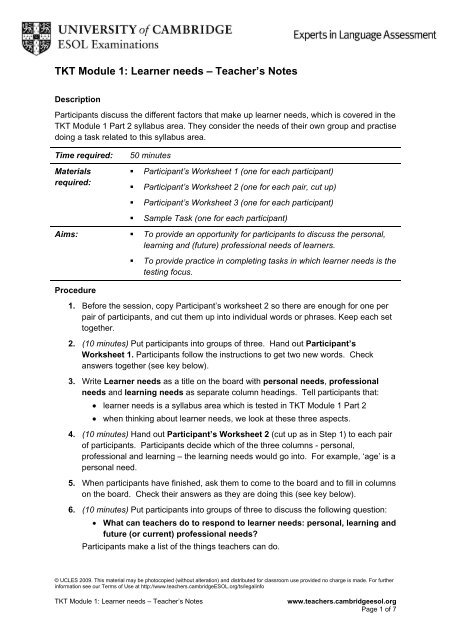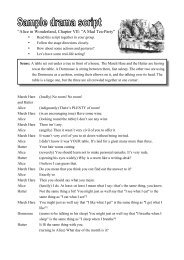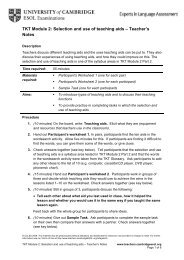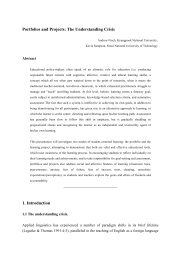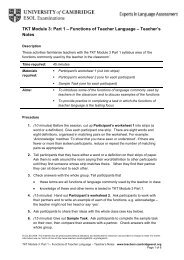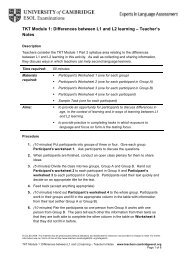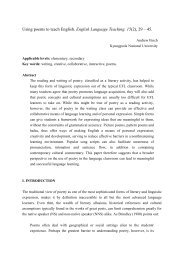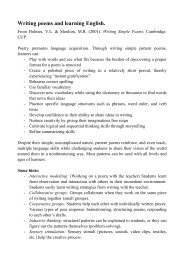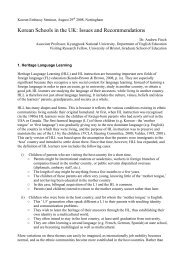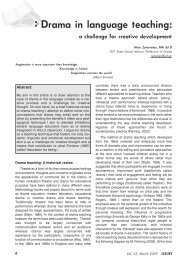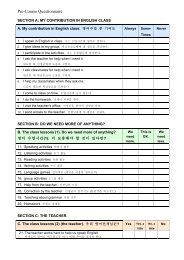Learner needs - Finchpark
Learner needs - Finchpark
Learner needs - Finchpark
Create successful ePaper yourself
Turn your PDF publications into a flip-book with our unique Google optimized e-Paper software.
TKT Module 1: <strong>Learner</strong> <strong>needs</strong> – Teacher’s NotesDescriptionParticipants discuss the different factors that make up learner <strong>needs</strong>, which is covered in theTKT Module 1 Part 2 syllabus area. They consider the <strong>needs</strong> of their own group and practisedoing a task related to this syllabus area.Time required:Materialsrequired:50 minutes• Participant’s Worksheet 1 (one for each participant)• Participant’s Worksheet 2 (one for each pair, cut up)• Participant’s Worksheet 3 (one for each participant)• Sample Task (one for each participant)Aims: • To provide an opportunity for participants to discuss the personal,learning and (future) professional <strong>needs</strong> of learners.Procedure• To provide practice in completing tasks in which learner <strong>needs</strong> is thetesting focus.1. Before the session, copy Participant’s worksheet 2 so there are enough for one perpair of participants, and cut them up into individual words or phrases. Keep each settogether.2. (10 minutes) Put participants into groups of three. Hand out Participant’sWorksheet 1. Participants follow the instructions to get two new words. Checkanswers together (see key below).3. Write <strong>Learner</strong> <strong>needs</strong> as a title on the board with personal <strong>needs</strong>, professional<strong>needs</strong> and learning <strong>needs</strong> as separate column headings. Tell participants that:• learner <strong>needs</strong> is a syllabus area which is tested in TKT Module 1 Part 2• when thinking about learner <strong>needs</strong>, we look at these three aspects.4. (10 minutes) Hand out Participant’s Worksheet 2 (cut up as in Step 1) to each pairof participants. Participants decide which of the three columns - personal,professional and learning – the learning <strong>needs</strong> would go into. For example, ‘age’ is apersonal need.5. When participants have finished, ask them to come to the board and to fill in columnson the board. Check their answers as they are doing this (see key below).6. (10 minutes) Put participants into groups of three to discuss the following question:• What can teachers do to respond to learner <strong>needs</strong>: personal, learning andfuture (or current) professional <strong>needs</strong>?Participants make a list of the things teachers can do.© UCLES 2009. This material may be photocopied (without alteration) and distributed for classroom use provided no charge is made. For furtherinformation see our Terms of Use at http://www.teachers.cambridgeESOL.org/ts/legalinfoTKT Module 1: <strong>Learner</strong> <strong>needs</strong> – Teacher’s Noteswww.teachers.cambridgeesol.orgPage 1 of 7
TKT Module 1: <strong>Learner</strong> <strong>needs</strong> – Answer KeysKey to Participant’s Worksheet 1RANLESPOP E R S O N A L6 4 10 8 1SONPERLOFSAINIEGANLRP R O F E S S I O N A L9 3L E A R N I N G2 7 5L E A R N E R N E E D S1 2 3 4 5 6 7 8 9 6 10Key to Participant’s Worksheet 2Personal <strong>needs</strong> Learning <strong>needs</strong> Professional <strong>needs</strong>age learning styles (future) employmentmale/femalecultural backgroundmotivationinterestseducational backgroundpast language learningexperienceslearning goals andexpectations for the courselearner autonomyavailability of time(future) traininggoing soon to an Englishspeaking universityKey to Sample Task1. B 2. A 3. D 4. F 5. C 6. G© UCLES 2009. This material may be photocopied (without alteration) and distributed for classroom use provided no charge is made. For furtherinformation see our Terms of Use at http://www.teachers.cambridgeESOL.org/ts/legalinfoTKT Module 1: <strong>Learner</strong> <strong>needs</strong> – Answer Keyswww.teachers.cambridgeesol.orgPage 3 of 7
TKT Module 1: <strong>Learner</strong> <strong>needs</strong> – Participant’s Worksheet 1Unscramble each of the jumbled words and write the letters in the boxes.RANLESPOSONPERLOFSAINIEGANLRP A6 4 10 8 1P F OL N2 7 59 3Copy the letters from the numbered cells above to boxes below, according to theirnumbers. What words do you get?1 2 3 4 5 6 7 8 9 6 10D© UCLES 2009. This material may be photocopied (without alteration) and distributed for classroom use provided no charge is made. For furtherinformation see our Terms of Use at http://www.teachers.cambridgeESOL.org/ts/legalinfoTKT Module 1: <strong>Learner</strong> <strong>needs</strong> – Participant’s Worksheet 1www.teachers.cambridgeesol.orgPage 4 of 7
TKT Module 1: <strong>Learner</strong> <strong>needs</strong> – Participant’s Worksheet 2(future)trainingmale/female(future)employmentlearning stylesavailability oftimepast languagelearningexperiencesgoing soon toan Englishspeakinguniversityculturalbackgroundlearning goalsandexpectationsfor the courseinterestsagelearnerautonomymotivationeducationalbackground© UCLES 2009. This material may be photocopied (without alteration) and distributed for classroom use provided no charge is made. For furtherinformation see our Terms of Use at http://www.teachers.cambridgeESOL.org/ts/legalinfoTKT Module 1: <strong>Learner</strong> <strong>needs</strong> – Participant’s Worksheet 2www.teachers.cambridgeesol.orgPage 5 of 7
TKT Module 1: <strong>Learner</strong> <strong>needs</strong> – Participant’s Worksheet 3What can teachers do to respond to learners’ <strong>needs</strong>?• Do a ‘<strong>needs</strong> analysis’ and/or find out about your learners’ personal <strong>needs</strong>, learning<strong>needs</strong> and future or current professional <strong>needs</strong>.• Select topics and subjects for lessons that fit with their interests and <strong>needs</strong>.• Select material that meets their <strong>needs</strong>.• Choose activities that fit with their learning styles, and are suitable for their <strong>needs</strong>and interests.• Decide on pace and interaction patterns.• Think about the balance of skills work (reading, listening, speaking, writing) inrelation to their <strong>needs</strong>.• Adopt approaches for teaching language that respond to their <strong>needs</strong>, interests andlearning styles.• Think about how to give learners feedback on their work.TKT Module 1: <strong>Learner</strong> <strong>needs</strong> – Participant’s Worksheet 3What can teachers do to respond to learners’ <strong>needs</strong>?• Do a ‘<strong>needs</strong> analysis’ and/or find out about your learners’ personal <strong>needs</strong>, learning<strong>needs</strong> and future or current professional <strong>needs</strong>.• Select topics and subjects for lessons that fit with their interests and <strong>needs</strong>.• Select material that meets their <strong>needs</strong>.• Choose activities that fit with their learning styles, and are suitable for their <strong>needs</strong>and interests.• Decide on pace and interaction patterns.• Think about the balance of skills work (reading, listening, speaking, writing) inrelation to their <strong>needs</strong>.• Adopt approaches for teaching language that respond to their <strong>needs</strong>, interests andlearning styles.• Think about how to give learners feedback on their work.© UCLES 2009. This material may be photocopied (without alteration) and distributed for classroom use provided no charge is made. For furtherinformation see our Terms of Use at http://www.teachers.cambridgeESOL.org/ts/legalinfoTKT Module 1: <strong>Learner</strong> <strong>needs</strong> – Participant’s Worksheet 3www.teachers.cambridgeesol.orgPage 6 of 7
TKT Module 1: <strong>Learner</strong> <strong>needs</strong> – Sample TaskFor Questions 1–6, match the <strong>needs</strong> of each group of students with the most suitable type ofcourse listed A–G.Mark the correct letter (A–G) on your answer sheet.There is one extra option which you do not need to use.Groups of students1 These young adults need a range of study skills before going to a Britishuniversity.2 These adult beginners are going on holiday, and need to learn how tocommunicate in an English-speaking environment.3 This group of young children have a short attention span; their parents wantthem to learn English while having some fun.4 These business people need to meet and work with people from other countriesat international conferences.5 These secretaries and receptionists want to focus on vocabulary and skillswhich are useful for them in their work.6 These scientists need to keep up-to-date with the latest developments in theirsubjects.Types of coursesABCDEFGa course focusing on basic language skills for everyday situations.a course focussing on listening and note-taking, and writing academic essaysa course based on role-plays and situations, such as greeting visitors andtelephoning clientsan activity based course with lots of games, songs and storiesa course based on grammar revision and written practicean oral skills course based on cross-cultural materialan online course in which students read texts on specific topics and answerdetailed comprehension.© UCLES 2009. This material may be photocopied (without alteration) and distributed for classroom use provided no charge is made. For furtherinformation see our Terms of Use at http://www.teachers.cambridgeESOL.org/ts/legalinfoTKT Module 1: <strong>Learner</strong> <strong>needs</strong> – Sample Taskwww.teachers.cambridgeesol.orgPage 7 of 7


